July 1-12, 2016 —
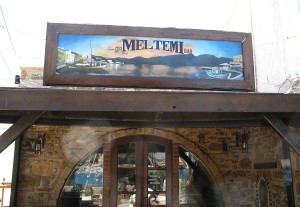 Our first meltimi in Greece this season was winding down so we started north from Kos to experience the northern Dodecanese islands. We had been in Kos for two days over our agreement for June but the management seemed OK with that, perhaps because there were still empty slips. With the extra time we were able to get some good maintenance projects done as well as make a long anticipated improvement to our holding tanks. Hylas installs a standard safety valve in the top of all holding tanks. It prevents the tank from imploding when an unusually powerful dock pump-out pump is used to pump the tanks.
Our first meltimi in Greece this season was winding down so we started north from Kos to experience the northern Dodecanese islands. We had been in Kos for two days over our agreement for June but the management seemed OK with that, perhaps because there were still empty slips. With the extra time we were able to get some good maintenance projects done as well as make a long anticipated improvement to our holding tanks. Hylas installs a standard safety valve in the top of all holding tanks. It prevents the tank from imploding when an unusually powerful dock pump-out pump is used to pump the tanks. 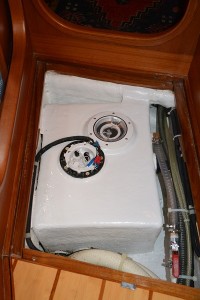 Unfortunately, the valve leaks a small amount of foul odor when the tanks get more than one half full. Bob came up with the idea of installing a removable clear plastic cap over the valve that could seal the valve when we are not being pumped out. After a fair amount of fiberglass work and some paint the cap was ready to bed on. It worked like a charm and has kept the boat odor free!
Unfortunately, the valve leaks a small amount of foul odor when the tanks get more than one half full. Bob came up with the idea of installing a removable clear plastic cap over the valve that could seal the valve when we are not being pumped out. After a fair amount of fiberglass work and some paint the cap was ready to bed on. It worked like a charm and has kept the boat odor free!
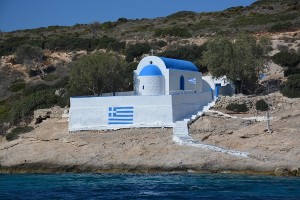 The tail end of the wind was still from the north, as were the seas, having them on our nose for most of the trip. Our first night we anchored in a secluded spot off the east coast of the small island of Plati. The only building ashore was a Greek church with its traditional white paint and blue dome. It looked freshly painted and ready for a congregation to show up. It was obvious there were no inhabitants on the island, but there was a small dock so the worshipers must arrive by boat. Goats wandering the hillsides were the only sign of life.
The tail end of the wind was still from the north, as were the seas, having them on our nose for most of the trip. Our first night we anchored in a secluded spot off the east coast of the small island of Plati. The only building ashore was a Greek church with its traditional white paint and blue dome. It looked freshly painted and ready for a congregation to show up. It was obvious there were no inhabitants on the island, but there was a small dock so the worshipers must arrive by boat. Goats wandering the hillsides were the only sign of life.
Plati Anchorage: 36˚56.39’ N, 027˚ 05.89’ E. Good holding in sand and weed in 5 meters. There is some protection from the meltimi but mostly from the north and north-west. Anchor off small concrete landing that is occasionally used by day-tripper boats.
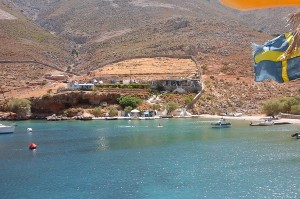 The following day, with the winds and seas still strong from the ending meltimi, we moved on to the next island, Kalimnos.
The following day, with the winds and seas still strong from the ending meltimi, we moved on to the next island, Kalimnos. 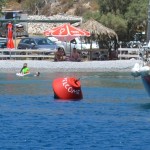 Discovering a bay on the east side of the island, we went in to explore. There we found a wonderful spot with two tavernas at the end of the bay and a small swimming beach. Moorings were set throughout the harbor painted one of two colors, depending on which taverna it belonged to, each had the word “welcome” painted on it. The moorings were a nice sight, very unusual for the Med, since Heikell´s guide book said it was poor holding with thin sand over hard bottom. The moorings are free for any yachts, with the natural expectation that you will have lunch or dinner at the taverna in return for use of the mooring. Even nicer! With cliffs around the bay it provided good protection from the winds and an excuse not to cook. Instead we spent time snorkeling along the shoreline then enjoyed a late dinner overlooking the boats lit up in the mooring field. This area is strictly seasonal. Once the yachts have ended the sailing season, the tavernas shut down as well.
Discovering a bay on the east side of the island, we went in to explore. There we found a wonderful spot with two tavernas at the end of the bay and a small swimming beach. Moorings were set throughout the harbor painted one of two colors, depending on which taverna it belonged to, each had the word “welcome” painted on it. The moorings were a nice sight, very unusual for the Med, since Heikell´s guide book said it was poor holding with thin sand over hard bottom. The moorings are free for any yachts, with the natural expectation that you will have lunch or dinner at the taverna in return for use of the mooring. Even nicer! With cliffs around the bay it provided good protection from the winds and an excuse not to cook. Instead we spent time snorkeling along the shoreline then enjoyed a late dinner overlooking the boats lit up in the mooring field. This area is strictly seasonal. Once the yachts have ended the sailing season, the tavernas shut down as well.
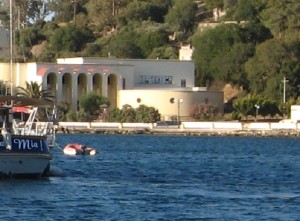 The winds were still blowing above 20 kts as we continued to motor sail north to Leros. Being eastern Greece another meltimi was due, so we tucked into Lakki, a deep and well protected bay on the west side of Leros. The meltimi arrived as forecast and a week later we are still anchored off the small town waiting for it to depart!
The winds were still blowing above 20 kts as we continued to motor sail north to Leros. Being eastern Greece another meltimi was due, so we tucked into Lakki, a deep and well protected bay on the west side of Leros. The meltimi arrived as forecast and a week later we are still anchored off the small town waiting for it to depart!
Lakki anchorage: 37˚07.73’ N, 026˚ 51.18’ E. Good holding in sand and weed. Make sure anchor is through weed and well set. Some areas in the anchorage have deep areas to avoid. Good access to town with public landing.
Leros is a fascinating island with its strong culture. The buildings around the harbor of Lakki are of Italian architecture, remnants of the Italian occupation (1912-1947) when the bay became an Italian naval base. Most older adults speak Italian as every child was required to learn both Greek and Italian when they were in school. That is no longer the case. This is also an island of old scooters, and everyone is riding one. We’re not sure if the scooters riders are riding more for work or pleasure but everyone seems to be enjoying them. 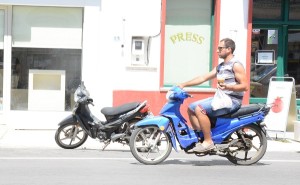 One of the coffee shops in town even makes their deliveries by scooter–water bottles under the arm, bag over the elbow, holding coffees in one hand and driving with the other. It was efficient!
One of the coffee shops in town even makes their deliveries by scooter–water bottles under the arm, bag over the elbow, holding coffees in one hand and driving with the other. It was efficient!
We took the local bus to the northeast side of the island for a day to do some exploring. It is always part of the cultural experience to take a local bus rather than renting a car. The bus operates on a schedule. As he drives, the driver honks the horn almost continuously, both letting waiting passengers know he is arriving and alerting oncoming traffic on some tight curves in the road. Greek music blares through the bus along the way. The driver makes change as he drives and is surrounded in his tight “office” with family photos, artificial flowers, box of tissues, and general clutter. The bus scooted north along the coast with breathtaking views of the shore 500 feet below taking narrow curves in the road, with only small trees on the side of the road as a guardrail.
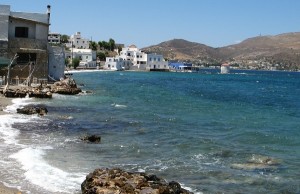 We let the driver know which town we wanted to get off at as our guide book is in English, and the town signs are in Greek. They look nothing alike! He left us off in Platanos where we walked along narrow neighborhood paths, most only wide enough for a scooter to pass. Homes have wonderful views of the harbor and the village below along with the hillsides on the far side of the bay. Greek neighborhoods are laid out so that every home has a view. It also reminded us that the layout of homes and winding paths is so confused, with no addresses listed, that for mail delivery the mailman just has to learn where you live. Homes are all concrete and always white. Bougainvillea and oleander grow everywhere with all of their brilliant color. A ten-minute walk down a steep hill brought us to the village of Agia Marina, right on the waterfront, where the cafes along the water were bustling with customers, vacationers and locals alike.
We let the driver know which town we wanted to get off at as our guide book is in English, and the town signs are in Greek. They look nothing alike! He left us off in Platanos where we walked along narrow neighborhood paths, most only wide enough for a scooter to pass. Homes have wonderful views of the harbor and the village below along with the hillsides on the far side of the bay. Greek neighborhoods are laid out so that every home has a view. It also reminded us that the layout of homes and winding paths is so confused, with no addresses listed, that for mail delivery the mailman just has to learn where you live. Homes are all concrete and always white. Bougainvillea and oleander grow everywhere with all of their brilliant color. A ten-minute walk down a steep hill brought us to the village of Agia Marina, right on the waterfront, where the cafes along the water were bustling with customers, vacationers and locals alike. 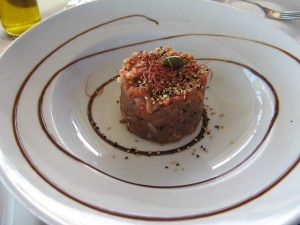 We ate a wonderful lunch at the cafe recommended by Lonely Planet and we were not disappointed. The tuna ceviche was to die for!
We ate a wonderful lunch at the cafe recommended by Lonely Planet and we were not disappointed. The tuna ceviche was to die for!
Unfortunately for the businesses the vacationers were few as we have seen in other parts of Greece. We spent a few hours exploring the waterfront shops and talking with some of the shopkeepers. It is a very inviting little community with lots of character.
In February of this year, Leros was established as a “hot spot” for migrant arrivals. It is where arriving migrants will be processed–both registered and fingerprinted, before moving on to a permanent place to live. At the present time there are 600 Syrian migrants living in Lakki. The government of Greece has recently converted a psychiatric hospital into housing.
Leros residents have taken care of migrants before, including refugees from Iraq and Afghanistan, since 2000. Many islanders are descendants of Greeks who were forced to move to Greece from Turkey during the population exchange in 1923 following the Turkish War of Independence. These Greeks understand from their older family members and neighbors the difficulties of being a refugee. The island population is 8,000. Last year alone it received 35,000 migrants.
Two nights ago we had watched from our boat, about 500 yards from the waterfront, a conflict between migrants and the Greek police. As we understand it, the migrants are frustrated waiting to move forward to other countries. At the same time they are living in small quarters with people of other religious beliefs. They include multiple Muslim sects as well as Christians, and they do not get along. The migrants had walked around the harbor to the waterfront with, what appeared to be all of their belongings demanding to be put on ferries and moved along. The two dozen or so island police arrived in riot gear and a standoff ensued. At some point tear gas was fired and the crowd got angry. We saw the migrants walk back around the harbor to where they are staying, followed by police and police cars. There has appeared to be no further confrontation. We did hear that a ferry came in overnight and a group of migrants left the island. This has been very frustrating for both the migrants and the islanders. Merchants say they have lost most of their tourist business this year because of the volume of migrants flowing in last season. They are also empathetic to the migrants and their situation.
On Wednesday morning we plan to leave for Patmos, a few islands to the north, to enjoy some quiet time before moving further north to seek protection from the next meltimi forecast for Tuesday—Number three!
